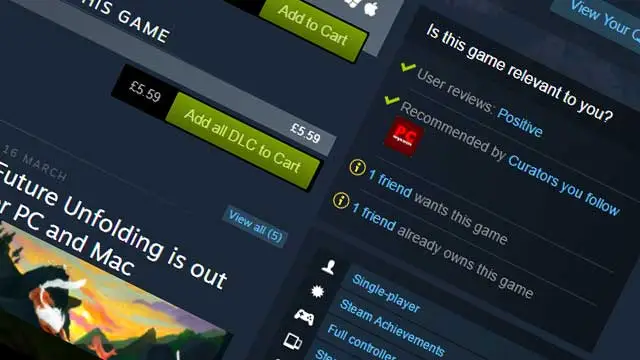Valve’s latest blog update explains how they recommend Steam games to users. Valve is trying hard to improve the Steam store but it’s a complicated process when they are trying to cater for such a massive pool of gamers.
The latest blog post attempts to address the issue of recommendations and how they are collecting the data to provide useful pointers to customers.
“Whenever we announce a change to the Steam Store, we’re always really interested to read the discussions that follow. Obviously, we see a wide range of opinions on how good a job the Store is doing, but increasingly we’re seeing that people have very different ideas of what its job even is – and what it should be.
“That’s understandable. One of the reasons it’s so hard to make a good store – one of the reasons we’ve been working on it for years, and one of the reasons we think we still have years of work left to do – is that it has so many jobs. It has to serve so many players whose tastes and interests are not only different but sometimes complete opposites”
Valve is trying to tackle this by looking at all the different types of gamers using the store which they have broken down as follows:
- Players who are highly connected to the online game community & conversations, and players who are totally unconnected
- Players who browse the store looking for a game, and players who arrive already knowing the title they’re looking for
- Players who come to the store once a month, and players who visit multiple times a day
- Players who just want to buy the latest AAA title, and players who want to search for hidden gems
- Players who want to play titles earlier in their development, and get involved in their evolution
- Players who want games with specific attributes, such as a type of gameplay, support for a specific technology, translation to their local language, etc
- Developers with AAA titles that have large, existing fan bases, and developers who are barely known, yet have a game that would be a hit if players found it
- Developers who want to build deliberately niche games, and have them find that niche audience
- Developers who want to get community feedback earlier in the development process
Valve would ideally like to please all the groups of gamers and developers using the Store but it should be done fairly. This is a tall order.
“We believe that a successful store would be one that treated all these people, both players and developers, in a manner that they would consider fair. Unfortunately, these groups often have competing interests, so it’s important to understand that if we’re not doing exactly what one group wants, it’s probably because we’re trying to weigh it against another group’s interests. It might seem obvious that developers have some competing interests, but it’s also true on the player side – some players specifically enjoy exploring Early Access titles, while others never want to see them.
“And ultimately, that is why the Steam Store is a design challenge. We could make the problem a lot simpler by choosing to ignore some set of players or developers, but we think there are already stores that have chosen to do that, and it’s much more interesting to try and figure out how to build a single store that works for everyone.”
The update explains how the store works and how it calculates what it thinks customers would want to see. By looking at data such as players’ actions, play history, logins, and information provided by developers, they try and calculate the recommendations. This sounds simple enough, but according to Valve, they struggle to evaluate whether the system is working as intended. They use DOTA 2‘ matchmaking as an example of how they want to fix this. By exposing the data as they did with DOTA 2 matchmaking, customers should start to understand the data which will help expose cases where it’s not working correctly.
To get improvements underway, from today game pages now show whether the Steam Store thinks customers will enjoy a game based on the store algorithms. The pages now show games you have played that are similar, whether curators you follow recommend it, what your friends own and want, and whether it’s a Steam top seller. The update explains:
“This section will let you see inside the black box, and understand what the Store is thinking. We hope it will be useful whenever you’re exploring the Store, but in particular, whenever you’ve navigated from an external web page directly to a specific game’s Store page. In those cases, this section will help you understand whether or not this game is something the Store would recommend to you. In other cases, you might be more or less interested in something the store recommends if you know exactly why it’s recommending it. For instance, knowing that a particular friend or curator likes or dislikes a game might make it clearer whether you’d like it. Finally, if the store recommends something you know you’re not interested in, you’ll be able to see where its decision making is going wrong, and tell us about it.”
Having tested this out earlier, it’s still hit and miss but that’s to be expected if your friends or curators you follow are not recommending the game you’re looking at. The more data available the more valuable this new box becomes.
This was the first post of three updates planned by Valve. The next update will look at how the store is being exploited and the this will cover the Steam Direct publishing fee. It’s great to see Valve explaining some of the systems and this move to more transparency is welcomed.







Published: May 9, 2017 03:07 am